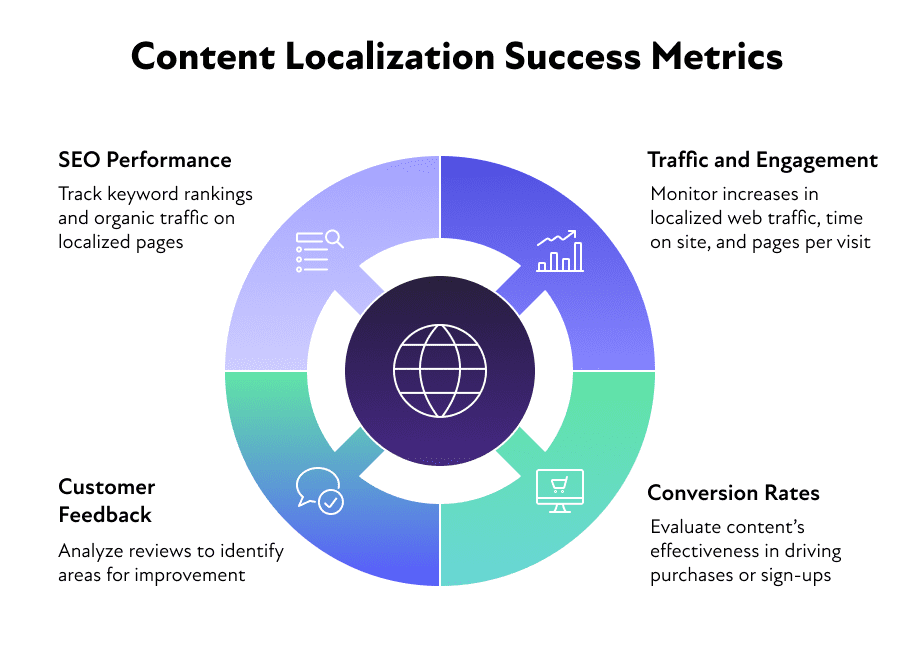Corinne Sharabi
Corinne is the Social Media and Content Lead at BLEND. She is dedicated to keeping global business professionals up to date on all things localization, translation, language and culture.


Expanding into new markets offers enormous growth opportunities for global businesses, but to succeed, your message needs to resonate with diverse audiences. This is where content localization comes into play. At its core, content localization is the process of adapting content to suit the cultural, linguistic, and functional expectations of a specific target market.
Unlike basic translation, which converts text from one language to another, localization takes a more comprehensive approach. It adjusts phrasing, visuals, design elements, and even cultural references to ensure the content feels natural and relevant to the audience it’s intended for. Localization aims to make the experience seamless, as though the content was created specifically for the local market.
For instance, localizing a product description for a Japanese audience might involve translating the text and adjusting the tone to match cultural expectations, ensuring measurements are in the metric system, and adapting visuals to align with Japanese aesthetics.
While many languages like English read left to right, others take the opposite approach. If you’re localizing content for an Arabic-speaking market, you’ll need to take into account right-to-left formatting and adjust layouts as necessary.
This level of attention to detail makes localization a powerful tool for businesses striving to establish a meaningful connection with their global audiences.

Translation involves adapting content from one language into another. Localization however approaches just about every aspect of your content assets. It can include tailoring marketing messages for local markets, reworking your branding, translating website content, and more.
In a rapidly globalizing world, content localization is no longer a luxury—it’s a necessity for businesses looking to expand their reach and build strong relationships with international consumers. But why is it so vital? The importance lies in how it bridges cultural and linguistic gaps, enabling brands to communicate authentically.
Localized content demonstrates respect and understanding for a market’s unique culture and preferences, which fosters trust and brand loyalty. For example, customers in Germany might appreciate precise, detail-oriented messaging, while audiences in Brazil might respond more favorably to warm, emotive language. Without localization, these nuances are easily missed, and a brand risks alienating potential customers.
Localization also enhances accessibility. By adapting your content to fit the norms of each market, you make your brand more approachable. Consider a global eCommerce business: offering payment options in local currencies, ensuring proper sizing charts, and even formatting dates correctly can significantly improve the user experience, boosting both customer satisfaction and conversion rates.
Moreover, effective localization has tangible business benefits. It improves search engine visibility by incorporating local keywords, helping you rank higher in regional searches. This drives organic traffic to your site and increases brand awareness.
In short, localization isn’t just about making content understandable—it’s about making it impactful.
Localization is most effective when integrated into your expansion strategy from the start. Ideally, businesses should localize their content before entering a new market. This ensures a strong first impression and positions the brand as a reliable, culturally aware player.
However, localization isn’t just for market entry. It’s equally critical for maintaining relevance in established markets. Localization is an ongoing process and should be a part of your big-picture content strategy. Seasonal campaigns, new product launches, and marketing updates all benefit from localization to keep the content fresh and aligned with evolving consumer expectations.
For example, localizing holiday promotions for various regions—such as Singles’ Day in China or Diwali in India—can help your brand capitalize on regional events, driving engagement and sales during peak shopping seasons.
As you expand into new markets, various types of content will need to be localized to ensure success. Ideally, you should prioritize content that raises your brand profile, enhances credibility, and drives conversions. Below, we’ll explore some key content types that require localization.
Marketing content is often the first point of contact with your audience, making its localization a top priority. Adapting your brand messaging for new markets requires a delicate balance: maintaining consistency with your global brand while ensuring your content resonates locally. Collaborating with native linguists who specialize in marketing ensures your campaigns connect authentically with your target audience while upholding your brand identity.
Software localization is a multifaceted process that requires product internationalization – adapting user interfaces (UI), user experiences (UX), and technical elements to align with local preferences. For example, time and date formats, numerical systems, and even color schemes may need to be adjusted to fit cultural norms.
It’s a good idea to consider localization from initial development, although retroactive localization is certainly possible. Investing in culturally appropriate design and functionality ensures that your product feels intuitive and relevant to users in every market.
Expanding into new territories often means navigating complex legal landscapes. From establishing corporate entities to complying with data protection regulations, legal content must be precise and compliant with local laws. Different regions may have unique rules and interpretations of legal terms, making this a critical area for localization.
To ensure accuracy and compliance, it’s essential to work with linguists who specialize in legal translation and localization. These experts understand both the language and the intricacies of legal frameworks, ensuring your content meets regulatory standards and avoids costly missteps.
When localizing content, you’re not simply translating words. Instead, you’re adapting your content holistically to cater to the unique preferences and expectations of your target market. Here are the critical components of effective content localization:
Localization also takes into account font compatibility and text expansion or contraction during translation. For example, German translations are often longer than their English counterparts, which can affect web layouts and user interfaces. Similarly, certain fonts may not support non-Latin scripts, requiring additional adjustments.
Developing a robust localization strategy involves several steps:
Understanding your target audience is the foundation of localization. Research cultural norms, language preferences, and consumer behaviors to tailor your content effectively. This is also a good opportunity to identify who your local competitors are and the types of content they produce.
Define what you want to achieve with localization, whether it’s increased brand awareness, higher conversion rates, or improved customer satisfaction.
Focus on localizing content that has the greatest influence on your audience, such as product descriptions, website homepages, landing pages, and customer support materials.
Find the right localization and translation solutions for your scope depending on the scale of content you’ll be localizing and the types of content management systems (CMS) you’re using. Try to find a solution that can connect directly to your CMS to streamline translation workflows.
Besides the right technology, you’ll also want to work with the right people. Work with professional linguists and cultural consultants who understand the nuances of your target market. Their expertise ensures authenticity and accuracy.
Invest time into creating style guides and glossaries. Not only will they help you nail wording for new markets, but they’ll ensure you remain consistent across all changes and content types.
Incorporate localized keywords into your content to improve visibility on regional search engines. This includes optimizing meta tags, headers, and URLs.
Get the most out of your content localization efforts by localizing the purchasing experience. To increase confidence and boost conversions, make sure you’re offering payment methods that local users trust.
Conduct user testing in your target market to gather feedback and make necessary adjustments. This iterative approach ensures your content meets local expectations.
Localization is a complex process that comes with its own set of challenges. Maintaining brand consistency while catering to diverse audiences can be difficult. For example, a global tech company might struggle to balance a unified brand voice with localized messaging for different regions.
To overcome this, businesses should establish clear style guides and glossaries that outline key terminology, tone, and branding guidelines. Regular communication between localization teams and regional managers also helps ensure alignment.

After deploying a content localization strategy, you’ll need to monitor it to measure success. There are many different metrics you can use to determine how sound an investment your content localization efforts have been.
Firstly, consider reach. How many new customers have you now reached by localizing content? Conversion and engagement rates are another useful measure of success. Look to see if pages per visit, time on site, and conversion rates have increased since localizing content.
It’s also worth examining user satisfaction. Identify negative reviews and other online content that speaks about your brand in a negative light. This will provide you with invaluable insights that can be used to shape content localization in the future.
Wherever you’re looking to expand your business, BLEND can help. Offering unbeatable industry expertise, our content localization services ensure smooth sailing as you navigate new markets. With an extensive selection of AI and human localization services and tools, it’s easier than ever to deliver native content that will inform, engage, and inspire customers.
Ready to learn more about how BLEND can help you? Get in touch with the team today.
What our customers are saying